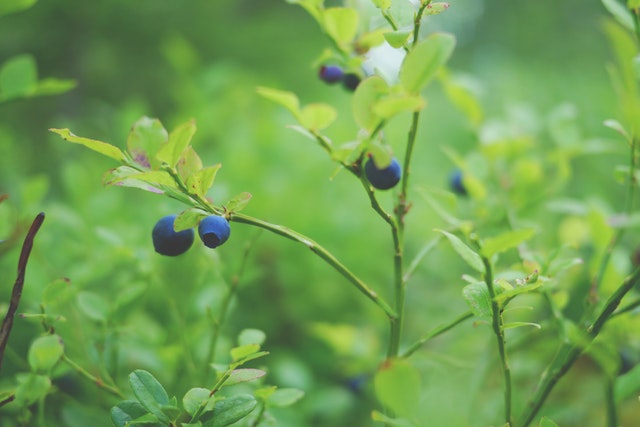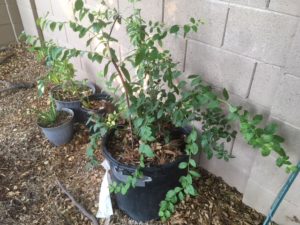Growing Blueberries in Hot, Dry Climates

Growing up in Northern Michigan, we would find wild blueberries in the woods that were amazing. We had some great tasting berries in that area of the country.
When I moved to Arizona, the berries that you purchased from the store just lacked flavor.
I had seen blueberry plants sold at local big box stores and heard of people trying to grow them in Arizona, so I figured why not.
Well my first attempt at growing Blueberries was a major fail, but I did learn some things along the way. After that experience, I told myself blueberries just weren’t for me.
I stumbled across a blueberry plant on clearance for $2.50 and decided to give it another shot.
Apparently I learned from some of my mistakes, since I’ve been able to get this blueberry plant through a few of our brutally hot summers.
Misty Blueberries
The variety I purchased is a Misty Blueberry, which is a Southern Highbush variety. Southern Highbush varieties have lower chill hour requirements and are more heat tolerant.
It is a good idea to get a second variety to cross pollinate for a higher yield. I just wanted to make sure that I could get one to survive before I thought about getting a second plant.
It seems to grow at a moderate rate and some of the shoots get to be between 4-6 feet. This variety seems to be a popular choice in my area and has held up pretty well.

Fruiting
I’ve had a couple handfuls of blueberries on my Misty plant.
They taste excellent! I’m hoping that I can get a decent amount without having a second plant for cross pollination.
The fruit ripen between May-June in my area. It’s still yet to be determined if you can get a super productive plant in our climate.
Gardening Skill Level
I would rate growing blueberries for the advanced gardener, so if you are looking for a challenge give it a shot.
There are much more productive and easier plants to grow in hot, dry climates.
Take a look at my post on overrated and underrated edible plants for hot, dry climates.
If you can maintain the acidic soil and have the proper microclimate for them to grow, that makes all the difference.
Suitable for Container Growing
Not only are blueberries suitable for growing in containers, it’s the only way to grow them in a hot, dry climate like the Arizona Desert.
Planting a blueberry plant directly in the ground in our high PH clay equals death to the blueberry plant.
I started my plant off in a 5 gallon container the first year and upped it into a 25 gallon pot.
Since they like to stay pretty moist, it doesn’t seem like you have to gradually work up to a larger pot like things that are susceptible to root rot.
Planting Tips
Other then what I’ve discussed regarding the proper acidic soil mix and planting them in containers, their aren’t really too many additional planting tips.
Many blueberry plants come bare root and should be planted when still dormant in early spring.
Blueberries need some chill hours below 45 degrees Fahrenheit and can handle our light frosts.
So you don’t have to worry about planting in a warm spot in the yard for the winter or thinking about cold protection.
It’s more about getting them in an area that will protect them from the intense summer sun.
Here is the recipe that I have had success with for my blueberry plants.
- ½ Peat Moss- Hoffman 15503 Canadian Sphagnum Peat Moss
- ½ Quality Potting Mix-
- Soil Sulphur 2-3 cups mixed into the soil Buy Here- 5LBS Sulfur Granular Sulphur Garden Pellets Soil
- A couple handfuls of worm castings- Unco Industries WWSB30LB Wiggle Worm Soil Builder Worm Castings
- Pine Bark and Pine needles as a top mulch layer- 2 Quarts Quarter Inch Pine Bark Fines
Watering
There are some fruit trees and edibles that like to dry slightly before watering, blueberries aren’t one of those types of plants.
Blueberry plants need to stay consistently moist.
One thing about using a lot of peat moss when mixing your soil, is that peat moss retains a lot of moisture, so you don’t have to water as much as you would think if your plant is in mostly shade.
The best water for blueberries is rain water, so if you have a system for harvesting rain water that will make your blueberry plants happy.
If not, using our city water does raise the PH, so I counter by adding about a tablespoon of vinegar per 2 gallons of water which has been effective for me.

Feeding
Blueberry plants are going to need an acidic fertilizer.
I tend to stay away from most chemical fertilizers, but I’ll admit I use an acidic based plant food from Miracle Gro for my blueberry plants once a month during the growing season.
I also foliar feed with liquid seaweed and iron. I just wanted something that would be faster acting, since many of the organic options are slow to feed.
For an organic option try:
I also top dress my plant with pine needles, pine bark, and twigs periodically to break down for nutrients.
I’ve heard of using coffee grounds as well, but haven’t used them myself. Avoid nitrate based nitrogen feeds.
Sun Exposure
Most things that you will read about blueberries will tell you how much blueberries love sun.
If you are living in a hot, dry climate with temps consistently in the triple digits, I would definitely keep your blueberries out of full sun.
My plant is under the canopy of a large Ash tree on an east facing wall.
It gets a few hours of early morning sun, than filtered sun through the tree canopy until 1.
This type of sun exposure has worked well for me.
My first attempt, I had my blueberry plant in sun with a 30% shade cloth until 2 and it completely fried.
Potential Problems
The major problems with having success with blueberry plants in a hot, dry climate is ensuring that the soil stays acidic, the blueberry plant is in a good micro climate, and it is getting watered properly.
I haven’t seen any issues with diseases and have had very few problems with pests on my blueberry plant.
I’ve occasionally cleaned off some aphids on new growth tips, but that’s about it.
Please comment below anything that you enjoyed about this post or your experiences with growing blueberries.

